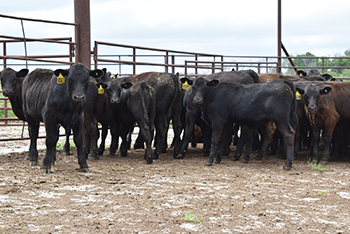Health management of early weaned beef calves

As forage resources dwindle in times of drought producers may need to consider early weaning options for the cow herd. Early weaning is designed to save body condition on the females by ending lactation and decreasing nutritional requirements. Getting each cow to a body condition score of 5.5 to 6 by calving is a key step in establishing reproductive success for the following year.
Terry Engelken of Veterinary Diagnostic & Production Animal Medicine at Iowa State University said early weaned calves may present health challenges as producers are now dealing with a younger and lighter calf than those weaned at the traditional date.
“How we manage these calves before and during the weaning process impacts on lifetime performance – whether they go to the feedyard or enter the herd as a replacement heifer,” he said. “We still argue about the best time to dehorn and castrate, and my answer is always, ‘The earlier the better.’ Making sure that these procedures are done in a timely fashion allows the calf time to heal and will decrease problems at weaning.”
Weaning needs to be well thought out to ease the transition. Stress associated with less than optimal pen conditions will be amplified in early weaned calves. Pens that are too wet or too dry can lead to poor performance and increased sickness. Areas containing tall weeds or seed heads can drive “pinkeye” outbreaks in weaned calves. Producers should watch the weather to avoid weaning in times of extreme heat stress. There are multiple extension publications on using fence-line weaning to reduce stress and improve postweaning weight gain in calves.
Engelken reminded producers that early-weaned calves have different nutritional requirements and more variation in feed intake compared to their traditionally-weaned contemporaries. Introducing creep feed prior to weaning may ease this transition. Enlisting the help of an experienced nutritionist will help avoid feeding upsets while maintaining needed performance. Although early weaning can extend pasture use by the cow herd, the calves are growing and require high quality feed.
Managing the health of these calves involves working with your veterinarian to select the correct vaccines and timing of delivery. One of the main concerns when building a vaccination program for young calves is the level of maternal antibody that remains from when they received colostrum as a newborn. There are indications that these antibodies may interfere with vaccine response and explains why your veterinarian may recommend intranasal vaccines for these younger calves. After calves reach 2 months of age, there is less concern with this interference and injectable products should work well.
Bovine respiratory disease and the clostridial complex are still the most common causes of health issues in beef calves. There are multiple options and combinations to provide protection against BRD such as injectable, intranasal, killed virus, modified live virus, and inactivated, and their content and timing can be very different. Standard 7-way blackleg vaccines are very effective in preventing disease. Engelken said Iowa’s Green Tag and Gold Tag recommendations are a great place for producers to start a discussion with their veterinarian on a program that will fit individual operations.
Calves also will need time to respond to these vaccinations. Administer vaccines at least two weeks prior to weaning to ensure the calf has time to respond and mount an effective immune response. Depending upon the producer’s marketing strategy, consider a booster vaccination to further improve immunity against these common disease pathogens. However, remember that vaccination is only part of the prevention program.
“How we manage the weaning process as a whole will dictate how successful we are with these calves,” Engelken said. “Early weaning can be a profitable way to stretch pasture and boost cow performance, but it does require adequate planning with your veterinarian and nutritionist to minimize weaning stress and optimize calf performance.”



